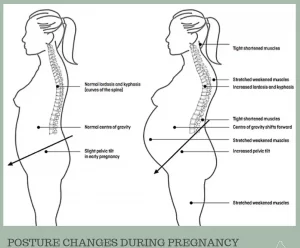During pregnancy, many changes occur to the body. Pain and discomfort can arise from the growing and changing body. Commonly, women will experience pelvic girdle or lower back pain throughout their pregnancy. However, a significant number of women will experience upper back (thoracic) or rib pain.
Where is the pain located?
The thoracic spine is located between the neck and lower back, roughly around the shoulder blade area. Upper back and rib pain might be less common, however it does occur and can be debilitating at times. The pain experienced can be a dull but intense pain which can be severe enough to restrict one’s ability to function. It will often gradually worsen throughout the day.
Thoracic and rib pain commonly occurs in, but is not restricted to, the third trimester. It is caused by a number different things.

Image credit: https://medium.com/@lovingparents121/low-back-pain-in-pregnancy-e772197b0fa3
Some of the main causes include:
- Centre of gravity shift.
As your baby grows, your centre of gravity shifts forwards and upwards. This can also be responsible for movement difficulties and balance function. To counteract the shift of centre of gravity, your thoracic spine is subsequently put under more pressure and stress to keep you upright. This increases the tension and load through the muscles and joints in the thoracic spine. - Hormone Relaxin.
Relaxin is released by the body in preparation for birth. It helps to soften and relax muscles, ligaments and tissues to allow room for childbirth. Relaxin affects the whole body, not just the pelvic area. This subsequently places more stress on the spine, impacting load through the area. This causes our muscles to work harder and can fatigue easily if not strong enough. - Movement in Ribs.
As the baby grows there is also a shift in your ribcage to allow room for the baby. This can indirectly affect the thoracic spine. Your rib cage attaches to the thoracic spine, so any pressure placed on the ribs can impact the thoracic and vice versa. Pain in the ribs can present around the sternum, tenderness along the ribs or the intercostal muscles between ribs. Rib pain can occur while sneezing, coughing or during a deep breath.
Factors that can predispose someone to thoracic or rib pain during pregnancy:
- Sustained poor postures.
- Standing for long periods of the day.
- An increase in breast tissue can increase the strain on the neck and thoracic area.
Typically, thoracic pain might feel like stiffness or decreased movement throughout the upper back. Some might feel strained or spasmed muscles that have been placed under increased pressure and load. Burning or sharp pains may also be felt and should always be assessed by a health care professional.

Helping to prevent thoracic pain during pregnancy:
- Strengthening muscles in the mid back.
- Maintaining a neutral standing and sitting posture as best as possible.
- Maintaining a neutral spine while sleeping.
- Trying to shift from standing to sitting often (not staying in one position for
long periods of time). - Trying to keep as mobile as possible.
- Wearing comfortable clothing/a supportive bra.
- Wearing supportive shoes without a heel.
- Trying to avoid lifting heavy objects.
Some simple exercises to maintain thoracic mobility during pregnancy include:
- Thread the needle.
- Book openers.
- Pectoral stretches.
- Cat/cow.
- Child’s pose.
- Seated thoracic rotation.
- Diagraphamatic breathing. Learn more here: https://portmelbournephysio.com.au/diaphragmatic-breathing/
- Sitting on a swiss ball.
Treatments for thoracic pain during pregnancy:
Massage, mobilising the spine, compression garments and heat can all help to manage pain and symptoms. Prevention by maintaining muscle strength and
movement (when safe to do so) are the best way to help manage pain. Our Physiotherapists can help to develop a safe program to help manage your
symptoms.
~ Alex Walker
Physiotherapist/Pelvic Health Physiotherapist
You may be interested in these other pregnancy-related PMPP blogs:

